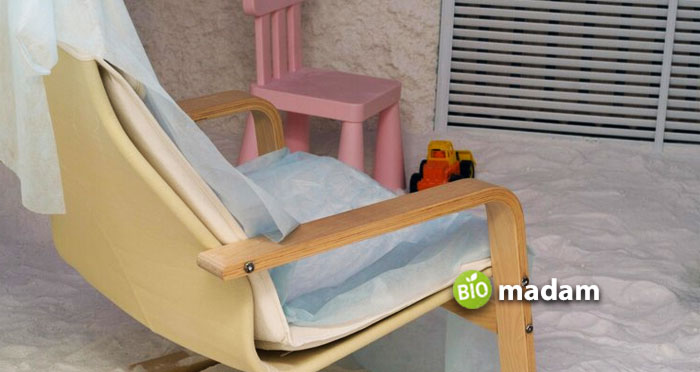Rocking chairs hold a special place in our hearts, offering a peaceful retreat from the world. Over time, however, the seat of your beloved rocking chair might start showing signs of wear and tear. The good news is that replacing the seat is a manageable DIY project that can bring back the comfort and beauty of your cherished chair. In this comprehensive guide, we’ll walk you through the entire process step by step, ensuring your rocking chair gets the rejuvenation it deserves.
What are the Parts of a Rocking Chair Called?
Understanding the different components of a rocking chair is essential before you delve into the replacement process. Each part plays a crucial role in the chair’s overall structure and comfort. Here’s a more detailed look at the main components:
- Seat: The chair’s sitting area, may be wood, cushioned with foam, or upholstered for comfort and style.
- Backrest: Positioned behind the seat, it offers crucial back support, enhancing overall comfort and ergonomics.
- Rockers: The curved elements beneath the chair enable the iconic rocking motion, providing a soothing experience.
- Frame: The structural foundation that supports and stabilizes the chair, sometimes contributing to its aesthetics.
Gather Your Tools and Materials to Replace the Seat
Before you begin, gather the necessary materials and tools:

Materials
- New seat (pre-made wooden or upholstered seat)
- Upholstery fabric (if applicable, for reupholstering the seat)
- Foam padding (if desired, for added comfort)
- Screws or nails (as needed for your chair’s design)
Tools
- Measuring tape
- Screwdriver
- Staple gun (if reupholstering)
- Hammer (if using nails)
- Pliers (for removing old staples, if applicable)
Remove the Old Seat
To ensure a smooth transition, it’s crucial to remove the old seat with care:
- Secure Placement: Begin by turning the rocking chair upside down and placing it on a soft surface. This prevents scratches or dings on the frame and ensures a stable position for seat removal.
- Gentle Fastener Removal: Use a screwdriver to gently remove any screws or nails that secure the old seat. If these fasteners are still in good condition, it’s a good idea to save them for the new seat. Pay attention to the fasteners’ locations and sizes, as these will guide the attachment of the new seat.
- Upholstery Care (if applicable): If the seat is upholstered, a little extra care is needed. Use pliers to carefully remove old staples that hold the fabric in place. Be patient and methodical to avoid tearing the fabric or causing unnecessary damage. Taking your time at this stage will ensure that the fabric remains intact for a smoother reupholstering process later if needed.
Measure and Prepare the New Seat
Preparing the new seat is essential for a successful replacement:
- Precise Measurement: Use a measuring tape to record the width, depth, and height of the seat area on the frame. Taking accurate measurements avoids alignment issues or instability.
- Upholstery Fabric (if applicable): If you’re using upholstery fabric to cover the seat, measure and cut it to match the size of the seat. Leave a few extra inches of fabric around the edges to ensure there’s enough material to secure it properly during reupholstering.
- Foam Padding Consideration: If you desire a more cushioned seat, consider adding foam padding. Measure the seat’s dimensions and cut the foam padding to match. Adding this layer of cushioning enhances your sitting experience, especially if the previous seat lacked adequate padding.
Attach the New Seat
With the new seat prepared, it’s time to securely attach it to the chair frame. The method you choose (screws or nails) will depend on your chair’s design and the materials involved:
- Screw Attachment: If your chair uses screws to secure the seat, carefully align the holes in the new seat with those in the chair frame. This alignment ensures stability. Use a screwdriver to securely fasten the screws, ensuring the seat is firmly held in place. Confirm that the screws are tight enough to provide a secure connection but avoid over-tightening, which could damage the seat or frame.
- Nail Attachment: If nails were the original fasteners, center the new seat on the frame. Gently hammer in the nails, ensuring they go through the seat and into the frame. Take care not to split the wood. Space the nails evenly to distribute weight and pressure, resulting in a secure and stable seat.
Reupholster the Seat (if applicable)
Here’s a detailed breakdown of the reupholstering process:

- Begin by laying the new upholstery fabric face down on a clean, flat surface. Ensure the fabric is free from wrinkles or creases for a professional finish.
- If you’re using foam padding, place it on top of the fabric, ensuring it’s centered and aligned with the seat’s dimensions.
- Carefully place the seat upside down on the fabric and padding, ensuring it’s centered and properly aligned. This is essential for achieving a symmetrical and well-finished look.
- Starting from one side of the seat, use a staple gun to attach the fabric to the seat’s underside. Pull the fabric taut as you staple, ensuring a smooth and wrinkle-free surface.
Add the Finishing Touches
After attaching the new seat, it’s time to add the final details:
- Trim Excess Fabric and Padding: Carefully trim any excess fabric or padding for a clean, professional appearance. This step not only improves the chair’s visual appeal but also ensures that the seat fits seamlessly within the frame.
- Verify Stability: Double-check that the seat is securely attached and stable on the chair frame. Test the seat by gently applying pressure and checking for any wobbling or shifting. Confirm that it’s firmly in place, as a secure seat is essential for safety.
- Comfort and Safety Test: Finally, give your rocking chair a test run to ensure that the new seat provides both comfort and safety while rocking. Sit in the chair, gently rock back and forth, and pay attention to any unusual sounds or sensations. A comfortable and stable seat enhances your enjoyment of the rocking chair.
Conclusion
In the end, you’ll see that you’ve successfully replaced the seat on your rocking chair, giving it a fresh start. This DIY project not only restores the functionality and comfort of your cherished chair but also allows you to revel in the satisfaction of a job well done. Now, take a moment to relax and enjoy the renewed beauty and comfort of your revitalized rocking chair. It’s a small yet meaningful victory in the world of furniture restoration!

People call me Domonique Smith in Ross! I was always fond of helping people, so opted an MBBS degree to pursue my passion as my career. My major interests fall in dealing with pregnant ladies and helping them in the best of my wills for their comfort. I am further planning to choose Gynecology as my major, so wish me luck!

